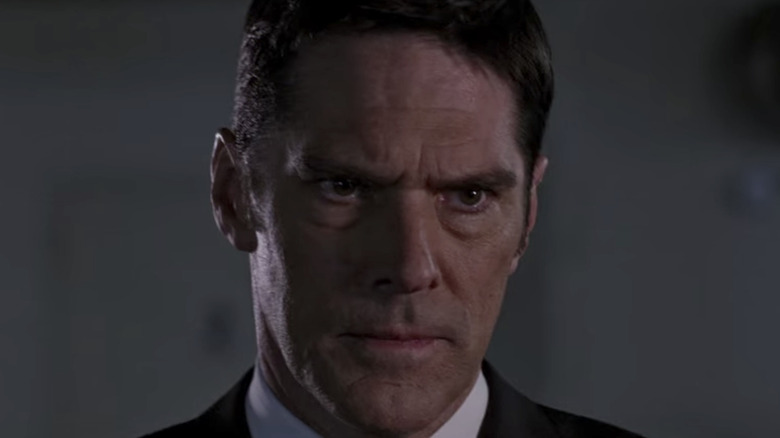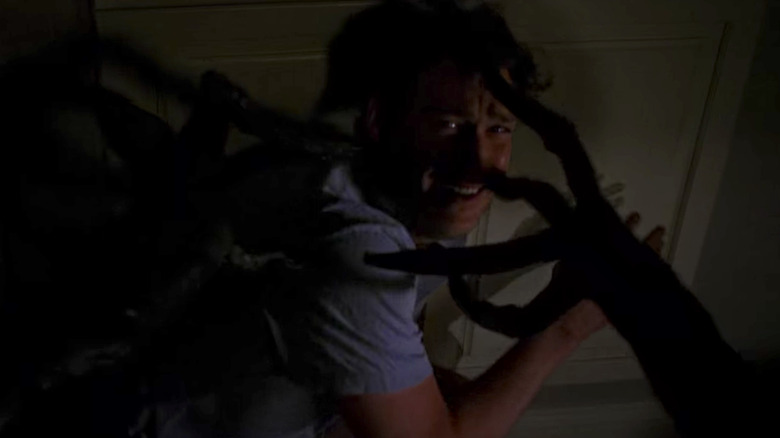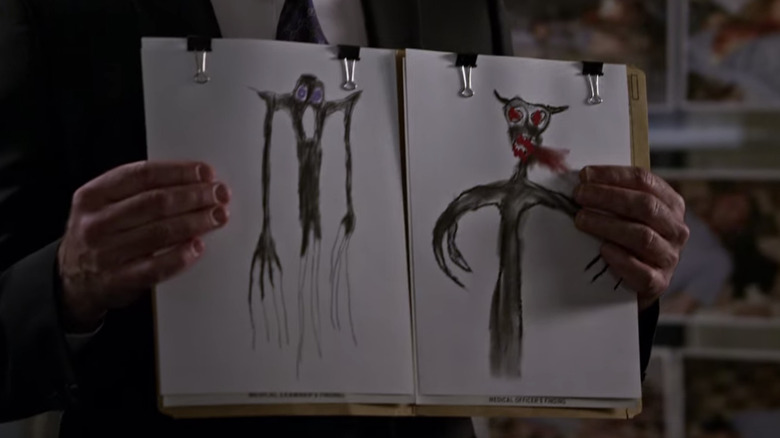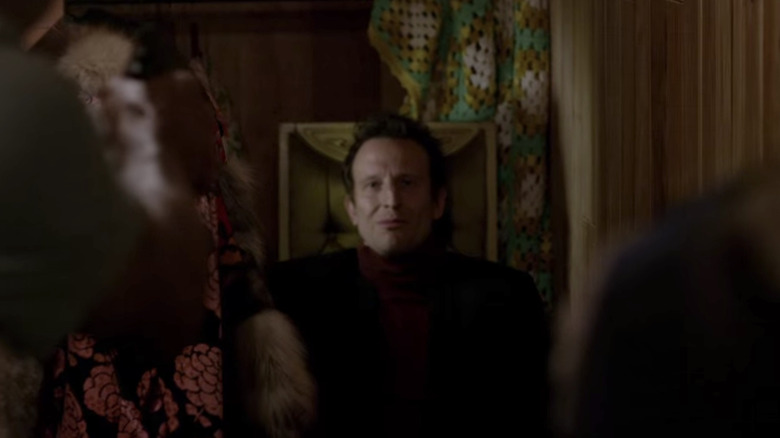Here's What Makes Criminal Minds Killer Mr. Scratch So Twisted
The Behavioral Analysis Unit of the hit CBS crime procedural "Criminal Minds" faced off against countless criminal masterminds over the course of its 15 seasons — including quite a few based on real killers — but some were definitely more twisted than others. One of the most wicked villains in the show's history was Mr. Scratch, a literal monster that tortures people, killing their loved ones then framing them for the murders. He appears in the Season 10 episode of the same name.
The murderous monster seems to have drawn some inspiration from Slender Man lore, which is surprising, as the fictional world of "Criminal Minds" seeks to emulate reality and rarely deals with the supernatural. But there is a logical explanation for these killings, and it's the BAU's job to figure it out. Mr. Scratch, with his long, pointed fingers capped by talons and croaking, clicking noises reminiscent of slowed-down bat echolocation (and which may have inspired the sounds of the monsters in "A Quiet Place"), isn't real. He is an elaborate trick from a very human monster, Peter Lewis (Bodhi Elfman), who manipulates innocent people to kill their families. Far from taking aim at random targets, however, Peter is exacting revenge for his father's death, which he blames on his innocent victims.
A sci-fi tale told twice, a befuddled BAU, and mounting murders
The episode begins with a man named Larry Merrin recounting his understanding of his wife's murder to BAU Chief Aaron "Hotch" Hotchner (Thomas Gibson): Unbelievable as it may sound, a monster did it in the smoky haze of burning sage. But after the title sequence, the audience gets a hint toward explaining this supernatural murder in a quote from John Irving, which says, "Your memory is a monster ... It ... summons ... with will of its own. You think you have a memory; but it has you." It'll take the BAU some time to figure out what's going on with Larry's case — and memory will play a key role — but the longer they take, the more people will die, as Larry's is not the only suspected killer hallucinating Mr. Scratch.
Two other people from different parts of the United States have jarringly similar accounts of the recent murders of their loved ones, although one is so disturbed she can't tell her story: Christine McNeil killed her boyfriend, and Daniel Karras murdered his adoptive mother. Christine, Daniel, and Larry are 33 or 34 years old and were adopted in 1985, although from different states. The BAU tosses around ideas, including the possibility that the three murderers had been drugged, although Dr. Reid (Matthew Gray Gubler) reminds everyone that drugs don't affect people in the exact same way, and these stories are nearly identical. Still scrambling to come up with an explanation for these murders, another related case comes across their desks: Bill Kinderman has killed himself, rather than his child, in a heartbreaking testament to the power of parental love.
With bodies piling up around the country under similar circumstances, the BAU needs to figure out who's behind Mr. Scratch ASAP.
The BAU puts the pieces together
While Dr. Reid and Agent David Rossi (Joe Mantegna) search Larry's house for clues, they stumble upon some suspicious tubes in an air conditioning vent near where Larry first began hallucinating Mr. Scratch. When the lab results come back, the BAU learns that the tubes tested positive for sevoflurane, which Reid says is "used to put you into a waking dream," and scopolamine, which heightens the suggestibility of a person who has been given a high dose. So it turns out drugs can partially explain the murders — but not fully. Why did Larry, Christine, and Daniel see the same thing? Bill's death by suicide holds the answer.
In an interview with Bill's ex-wife, Hotch learns that Bill had repeatedly told her these wild stories about his past that just could not have been true — these are false recovered memories. This leads the BAU to link these murders to the 1980s moral panic over "Satanic Ritual Abuse." Maybe the villain behind Mr. Scratch had been a falsely accused child abuser, and now he's getting revenge on the kids who were encouraged to identify him as a pedophile?
Thanks to some off-the-record help from the NSA, the team identifies the man behind Mr. Scratch as Peter Lewis, whose father was jailed — then murdered in prison — for allegedly being a satanic child abuser. With Peter identified, the BAU knows who the final victim/murderer will be: Dr. Susannah Regan, who wrote a book encouraging police to believe anything a child said, even when they were clearly pushed to make up a story.
When Hotch arrives alone at Dr. Regan's house, she, already drugged, calls him into her study to watch her stab herself at the command of Peter, who then drugs Hotch.
Who's the real winner?
Although drugged, Hotch fights to stay in control of himself and even gets into Peter's head at one point. Peter inadvertently reveals that he had been Dr. Regan's patient when he mentions that she would burn sage during her interviews with children to calm their nerves. It becomes clear that he, like the other children, had been tricked into creating false memories of his father's pedophilia and therefore feels responsible for his dad getting murdered in prison. (Why he gives himself a pass and not Larry, Christine, Daniel, and Bill can only be explained by his own selective memory.)
Using hypnosis, Peter eventually breaks into Hotch's nearly impenetrable head, learning that his worst fear is being the cause of the deaths of his agents. He manipulates Hotch into thinking that the team, which is about to burst through the front door of Dr. Regan's home, is himself, so that Hotch will kill his team. But Peter underestimates Hotch's ability to stay in control of his own mind, and as soon as Rossi opens the door, he turns around to shoot at Peter.
Although he escapes, Peter ultimately surrenders, having killed the last person on his hit list. But the story doesn't stop there, as Peter returns for a number of episodes in later seasons. Clearly, it was the BAU — not the villain — that lost this round.



